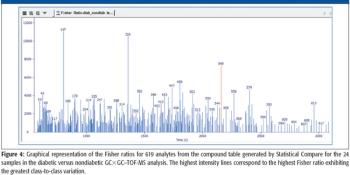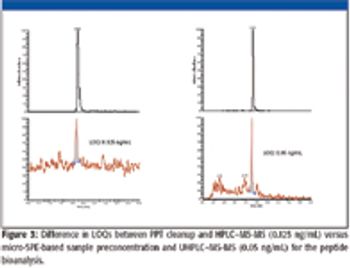
Special Issues
Liquid chromatography coupled to mass spectrometry (LC–MS) using electrospray ionization (ESI) is a powerful analytical tool for the analysis of a wide molecular weight range of polar, semivolatile, and thermally labile compounds.

Special Issues
Liquid chromatography coupled to mass spectrometry (LC–MS) using electrospray ionization (ESI) is a powerful analytical tool for the analysis of a wide molecular weight range of polar, semivolatile, and thermally labile compounds.

Special Issues
Accurate, sensitive, and comprehensive characterization of monoclonal antibodies is an absolute necessity to the pharmaceutical and diagnostic industries to meet regulatory requirements and ensure the efficacy and safety of the final product. Microfluidic chip-based high performance liquid chromatography technology interfaced with the mass accuracy of quadrupole time-of-flight mass spectrometry provides the ability to rapidly and efficiently assess the quality of intact monoclonal antibodies, confirm their amino acid sequence, and determine their glycosylation state, while consuming very small amounts of these precious products.

Special Issues
The analysis of amines by gas chromatograph ;mass spectrometry (GC–MS) using electron ionization (EI) has always been a challenge

Special Issues
Two-dimensional gas chromatography–time-of-flight mass spectrometry (GCÃ-GC–TOF-MS) analysis has emerged as one of the technologies of choice for the analysis of small metabolite profiles. The results of these analyses produce substantial quantities of data that can be extremely time-consuming and labor-intensive for the analyst to interpret. New software provides a tool for the scientist to use as a data-mining strategy to find significant results from large, complex data sets. This proof of concept research was conducted using comprehensive GCÃ-GC–TOF-MS to elucidate the small-molecule metabolite profiles of diabetic and nondiabetic urine in search of key differences between disease-state and nondisease-state individuals.

Special Issues
Mass spectrometry plays an increasingly significant role in the analysis of residues and contaminants in food. Here we will illustrate how the combination of ultrahigh-pressure liquid chromatography (UHPLC) and high-resolution time-of-flight-mass spectrometry (TOF-MS) is used to generate a screen of veterinary drug residues in products of animal origin. The use of UHPLC–TOF-MS and dedicated, workflow directed software allows rapid screening for large numbers of residues and automated quantification of positive samples. In addition, we illustrate how the data generated using MSE acquisition mode enable critical structural information to be collected, which offers additional selectivity and confirmatory data for compound identification and facilitates elucidation of the structure of newly discovered compounds.

Special Issues
In preclinical development, the absolute quantification of peptides in biological matrices becomes a challenge due to the limited availability of stable label internal standards and affinity-based cleanup. This puts a renewed emphasis on matrix effects, especially for the bioanalysis of hydrophobic peptides. While the impact of matrix effects has been studied for extensively singly charged small molecules, their effect on multiply charged compounds has yet to be characterized fully. This article discusses initial results from matrix effect experiments in relation to the bioanalysis of hydrophobic peptides and techniques used to minimize matrix effects.